View in other NatureServe Network Field Guides
NatureServe
Montana
Utah
Wyoming
Idaho
Wisconsin
British Columbia
South Carolina
Yukon
California
New York
Striped Skunk - Mephitis mephitis
Native Species
Global Rank:
G5
State Rank:
S5
(see State Rank Reason below)
Agency Status
USFWS:
USFS:
BLM:
External Links
State Rank Reason (see State Rank above)
Species is common and widely distributed. It is likely stable and faces minor threats from vehicle collisions
General Description
About the size of a house cat. Well-developed scent glands that emit a very strong odor. Often the presence of a skunk is first detected by its odor. Black body, narrow white stripe on middle of the forehead, broad white area on nape that usually divides into a V at the shoulders. Great variation in color pattern and size of stripes. Total length: 20 to 28 inches. Weight: six to 14 pounds. Mostly nocturnal and does not hibernate. Uses ground burrows, abandoned building foundations, and wood or rock piles as den sites. Will use dens created by other animals. When frightened or threatened, sprays a strong and long-lasting musk produced by anal scent glands.
Diagnostic Characteristics
A few specimens of the Spotted Skunk have been captured in Montana. The Spotted Skunk has a black spot on forehead, one under each ear, and four broken white strips along neck, back, and sides.
Species Range
Montana Range
Range Descriptions
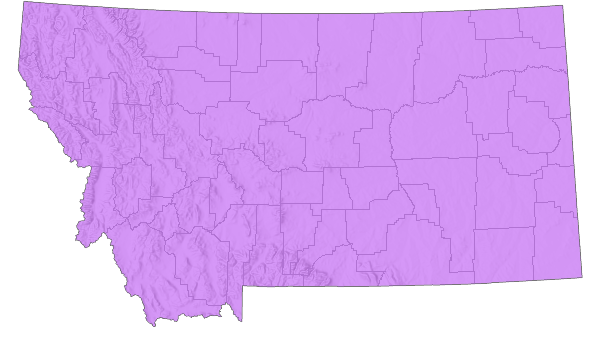
 Native
Native
Global Range

Estimated global breeding range area is: 13,213,301 km
2 (Approximately 3% in Montana)
See information about
 iNaturalist Geomodels
iNaturalist Geomodels
Observations in Montana Natural Heritage Program Database
Number of Observations: 991
(Click on the following maps and charts to see full sized version)
Map Help and Descriptions
Relative Density
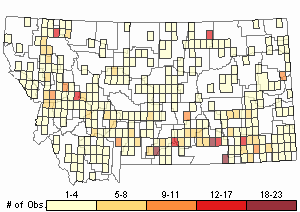
Recency
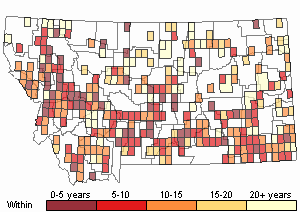
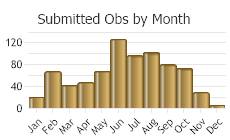
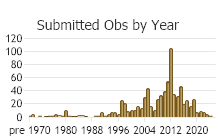
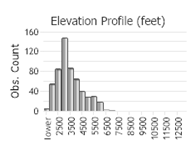 (Observations spanning multiple months or years are excluded from time charts)
(Observations spanning multiple months or years are excluded from time charts)
Migration
Non-migratory.
Habitat
Lives in a variety of habitats including semi-open country, mixed woods, brushland, and open prairie. Most abundant in agricultural areas where there is ample food and cover. Usually absent where water table is too high for making ground dens. Forest edges, open woodland, brushy grassland, riparian vegetation, cultivated lands (Hoffmann and Pattie 1968).
National Vegetation Classification System Groups Associated with this Species
Forest and Woodland
Deciduous Forest and Woodland
Low Elevation - Xeric Forest and Woodland
Montane - Subalpine Forest and Woodland
Shrubland
Arid - Saline Shrubland
Foothills - Montane Shrubland
Sagebrush Shrubland
Grassland
Lowland - Prairie Grassland
Montane - Subalpine Grassland
Sparse and Barren
Sparse and Barren
Wetland and Riparian
Alkaline - Saline Wetlands
Peatland
Riparian and Wetland Forest
Riparian Shrubland
Wet Meadow and Marsh
Recently Disturbed or Modified
Harvested Forest
Insect-Killed Forest
Introduced Vegetation
Recently Burned
Human Land Use
Agriculture
Developed
Food Habits
Omnivorous, eating more animal than plant matter. Proportional composition of diet varies. Small mammals, reptiles, amphibians, berries, fruit, garbage, cariion, bird eggs, and arthropods (Jones et al. 1983).
Ecology
Adults are solitary except during breeding season, and in communal winter dens. Can carry a heavy parasite load, sometimes rabies (Jones et al. 1983).
Reproductive Characteristics
Mating occurs during February and April; 59 to 77 days gestation; may exhibit delayed implantation; young born during May or June; five to six young is the usual litter size.
Stewardship Responsibility
References
- Literature Cited AboveLegend:
 View Online Publication
View Online Publication Hoffmann, R.S. and D.L. Pattie. 1968. A guide to Montana mammals: identification, habitat, distribution, and abundance. Missoula, MT: University of Montana. 133 p.
Hoffmann, R.S. and D.L. Pattie. 1968. A guide to Montana mammals: identification, habitat, distribution, and abundance. Missoula, MT: University of Montana. 133 p. Jones, J.K., D.M. Armstrong, R.S. Hoffmann and C. Jones. 1983. Mammals of the northern Great Plains. University of Nebraska Press, Lincoln. 379 pp.
Jones, J.K., D.M. Armstrong, R.S. Hoffmann and C. Jones. 1983. Mammals of the northern Great Plains. University of Nebraska Press, Lincoln. 379 pp.
- Additional ReferencesLegend:
 View Online Publication
View Online Publication
Do you know of a citation we're missing? Adelman, E.B. 1979. A survey of the nongame mammals in the Upper Rattlesnake Creek drainage of western Montana. M.S. thesis. University of Montana, Missoula. 129 pp.
Adelman, E.B. 1979. A survey of the nongame mammals in the Upper Rattlesnake Creek drainage of western Montana. M.S. thesis. University of Montana, Missoula. 129 pp. Allen, A.W. 1987. The relationship between habitat and furbearers. Pages 164-179 in M. Novak, J.A. Baker, M.E. Obbard, and B. Malloch, eds. Wild Furbearer Management and Conservation in North America. Ontario Trappers Assn. and Ontario Ministry Nat. Res., Toronto, Ontario.
Allen, A.W. 1987. The relationship between habitat and furbearers. Pages 164-179 in M. Novak, J.A. Baker, M.E. Obbard, and B. Malloch, eds. Wild Furbearer Management and Conservation in North America. Ontario Trappers Assn. and Ontario Ministry Nat. Res., Toronto, Ontario. Allen, T.D.H. 2011. Wildlife guards for deer and Black Bear. M.Sc. Thesis. Bozeman, Montana: Montana State University. 71 p.
Allen, T.D.H. 2011. Wildlife guards for deer and Black Bear. M.Sc. Thesis. Bozeman, Montana: Montana State University. 71 p. Anaconda Minerals Company, and Camp, Dresser & McKee. 1981. Anaconda Stillwater Project 6-month environmental baseline report. CDM Project No. 3139. Vol. I Appendix. Jan. 15, 1981.
Anaconda Minerals Company, and Camp, Dresser & McKee. 1981. Anaconda Stillwater Project 6-month environmental baseline report. CDM Project No. 3139. Vol. I Appendix. Jan. 15, 1981. Andis, Adam. 2016. Performance measures of road crossing structures from relative movement rates of large mammals. M.S. Thesis. University of Montana. Missoula, MT.
Andis, Adam. 2016. Performance measures of road crossing structures from relative movement rates of large mammals. M.S. Thesis. University of Montana. Missoula, MT. Bauer, Delane, 2002, 2002 Four Seasons Wildlife Study. Savage Mine Report, Richland County, Montana.
Bauer, Delane, 2002, 2002 Four Seasons Wildlife Study. Savage Mine Report, Richland County, Montana. Carlsen, T. and R. Northrup. 1992. Canyon Ferry Wildlife Management Area Final Draft Management Plan. March 1992.
Carlsen, T. and R. Northrup. 1992. Canyon Ferry Wildlife Management Area Final Draft Management Plan. March 1992. Chapman, J.A., and G.A. Feldhamer. 1982. Wild mammals of North America: biology, management, and economics. Johns Hopkins University Press, Baltimore, Maryland.
Chapman, J.A., and G.A. Feldhamer. 1982. Wild mammals of North America: biology, management, and economics. Johns Hopkins University Press, Baltimore, Maryland. Confluence Consulting Inc. 2010. Montana Department of Transportation Wetland Mitigation Monitoring Reports (various sites). MDT Helena, MT.
Confluence Consulting Inc. 2010. Montana Department of Transportation Wetland Mitigation Monitoring Reports (various sites). MDT Helena, MT. Confluence Consulting Inc. 2011. Montana Department of Transportation Wetland Mitigation Monitoring Reports (various sites). MDT Helena, MT.
Confluence Consulting Inc. 2011. Montana Department of Transportation Wetland Mitigation Monitoring Reports (various sites). MDT Helena, MT. Confluence Consulting Inc. 2013. Montana Department of Transportation Wetland Mitigation Monitoring Reports (various sites). MDT Helena, MT.
Confluence Consulting Inc. 2013. Montana Department of Transportation Wetland Mitigation Monitoring Reports (various sites). MDT Helena, MT. Cross, James, and Richard P. Weckwerth, 1978, Upland Game Bird (and Fur Survey) Inventory. Wildlife Investigations, Region One. W-130-R-9, Job No. II-1, July 1, 1977 - June 30, 1978.
Cross, James, and Richard P. Weckwerth, 1978, Upland Game Bird (and Fur Survey) Inventory. Wildlife Investigations, Region One. W-130-R-9, Job No. II-1, July 1, 1977 - June 30, 1978. Cross, James, and Richard P. Weckwerth, 1980, Upland Game Bird (and Fur Survey) Inventory. Wildlife Investigations, Region One. W-130-R-11, Job No. II-1, July 1, 1979 - June 30, 1980.
Cross, James, and Richard P. Weckwerth, 1980, Upland Game Bird (and Fur Survey) Inventory. Wildlife Investigations, Region One. W-130-R-11, Job No. II-1, July 1, 1979 - June 30, 1980. Cross, James, and Richard P. Weckwerth, 1981, Upland Game Bird (and Fur Survey) Inventory. Wildlife Investigations, Region One. W-130-R-12, Job No. II-1, July 1, 1980 - June 30, 1981.
Cross, James, and Richard P. Weckwerth, 1981, Upland Game Bird (and Fur Survey) Inventory. Wildlife Investigations, Region One. W-130-R-12, Job No. II-1, July 1, 1980 - June 30, 1981. Cross, James, and Richard P. Weckwerth, 1982, Upland Game Bird (and Fur Survey) Inventory. Wildlife Investigations, Region One. W-130-R-13, Job No. II-1, July 1, 1981 - June 30, 1982.
Cross, James, and Richard P. Weckwerth, 1982, Upland Game Bird (and Fur Survey) Inventory. Wildlife Investigations, Region One. W-130-R-13, Job No. II-1, July 1, 1981 - June 30, 1982. Cross, James, and Richard P. Weckwerth, 1983, Upland Game Bird (and Fur Survey) Inventory. Wildlife Investigations, Region One. W-130-R-14, Job No. II-1, July 1, 1982 - June 30, 1983.
Cross, James, and Richard P. Weckwerth, 1983, Upland Game Bird (and Fur Survey) Inventory. Wildlife Investigations, Region One. W-130-R-14, Job No. II-1, July 1, 1982 - June 30, 1983. Deems, E.F., Jr. and D. Pursley (eds). 1978. North American furbearers: their management, research and harvest status in 1976. Int. Assoc. Fish and Wildlife Agencies and University of Maryland. 171 p.
Deems, E.F., Jr. and D. Pursley (eds). 1978. North American furbearers: their management, research and harvest status in 1976. Int. Assoc. Fish and Wildlife Agencies and University of Maryland. 171 p. Dood, A.R. 1980. Terry Badlands nongame survey and inventory final report. Montana Department of Fish, Wildlife, and Parks and Bureau of Land Management, Helena, MT. 70 pp.
Dood, A.R. 1980. Terry Badlands nongame survey and inventory final report. Montana Department of Fish, Wildlife, and Parks and Bureau of Land Management, Helena, MT. 70 pp. ECON, Inc. (Ecological Consulting Service), Helena, MT., 1976, Colstrip 10 x 20 Area wildlife and wildlife habitat annual monitoring report, 1976. Proj. 135-85-A. December 31, 1976.
ECON, Inc. (Ecological Consulting Service), Helena, MT., 1976, Colstrip 10 x 20 Area wildlife and wildlife habitat annual monitoring report, 1976. Proj. 135-85-A. December 31, 1976. ECON, Inc. (Ecological Consulting Service), Helena, MT., 1977, Colstrip 10 x 20 Area wildlife and wildlife habitat annual monitoring report, 1977. Proj. 164-85-A. December 31, 1977.
ECON, Inc. (Ecological Consulting Service), Helena, MT., 1977, Colstrip 10 x 20 Area wildlife and wildlife habitat annual monitoring report, 1977. Proj. 164-85-A. December 31, 1977. ECON, Inc. (Ecological Consulting Service), Helena, MT., 1979, Annual wildllife report of the Colstrip Area for 1978. Proj. 195-85-A. April 6, 1979.
ECON, Inc. (Ecological Consulting Service), Helena, MT., 1979, Annual wildllife report of the Colstrip Area for 1978. Proj. 195-85-A. April 6, 1979. ECON, Inc. (Ecological Consulting Service), Helena, MT., 1979, Annual wildllife report of the Colstrip Area for 1979, including a special raptor research study. Proj. 216-85-A. March 1, 1980.
ECON, Inc. (Ecological Consulting Service), Helena, MT., 1979, Annual wildllife report of the Colstrip Area for 1979, including a special raptor research study. Proj. 216-85-A. March 1, 1980. Farmer, Patrick J., and Thomas W. Butts, Western Technology & Eng., Inc., Helena, MT., 1994, McDonald Project Terrestrial Wildlife Study, November 1989 - November 1993. April 1994. In McDonald Gold Project: Wildlife & Fisheries. [#18]. Seven-up Pete Joint Venture, Lincoln, MT. Unpub. No date.
Farmer, Patrick J., and Thomas W. Butts, Western Technology & Eng., Inc., Helena, MT., 1994, McDonald Project Terrestrial Wildlife Study, November 1989 - November 1993. April 1994. In McDonald Gold Project: Wildlife & Fisheries. [#18]. Seven-up Pete Joint Venture, Lincoln, MT. Unpub. No date. Fjell, Alan K., 1986, Peabody Coal Company Big Sky Mine, Rosebud County, MT. Wildlife monitoring report: 1985 field season. March 1986.
Fjell, Alan K., 1986, Peabody Coal Company Big Sky Mine, Rosebud County, MT. Wildlife monitoring report: 1985 field season. March 1986. Fjell, Alan K., and Brian R. Mahan., 1985, Peabody Coal Company Big Sky Mine, Rosebud County, MT. Wildlife monitoring report: 1984 field season. February 1985.
Fjell, Alan K., and Brian R. Mahan., 1985, Peabody Coal Company Big Sky Mine, Rosebud County, MT. Wildlife monitoring report: 1984 field season. February 1985. Foresman, K.R. 2001. The wild mammals of Montana. American Society of Mammalogists, Special Publication Number 12. Lawrence, KS. 278 pp.
Foresman, K.R. 2001. The wild mammals of Montana. American Society of Mammalogists, Special Publication Number 12. Lawrence, KS. 278 pp. Foresman, K.R. 2012. Mammals of Montana. Second edition. Mountain Press Publishing, Missoula, Montana. 429 pp.
Foresman, K.R. 2012. Mammals of Montana. Second edition. Mountain Press Publishing, Missoula, Montana. 429 pp. Gniadek, S. 1983. Southwest Glendive Wildlife Baseline Inventory. Miles City, Mont: Bureau of Land Management, Miles City District Office. 56 pp with appendices.
Gniadek, S. 1983. Southwest Glendive Wildlife Baseline Inventory. Miles City, Mont: Bureau of Land Management, Miles City District Office. 56 pp with appendices. Haight, C.P. 1937. Some observations on the predator-prey complex in the Gallatin Valley. M.Sc. Thesis. Bozeman, Montana: Montana State University. 58 p.
Haight, C.P. 1937. Some observations on the predator-prey complex in the Gallatin Valley. M.Sc. Thesis. Bozeman, Montana: Montana State University. 58 p. Hanauska-Brown, L., B.A. Maxell, A. Petersen, and S. Story. 2014. Diversity Monitoring in Montana 2008-2010 Final Report. Montana Fish, Wildlife & Parks. Helena, MT. 78 pp.
Hanauska-Brown, L., B.A. Maxell, A. Petersen, and S. Story. 2014. Diversity Monitoring in Montana 2008-2010 Final Report. Montana Fish, Wildlife & Parks. Helena, MT. 78 pp. Hendricks, P., S. Lenard, D.M. Stagliano, and B.A. Maxell. 2013. Baseline nongame wildlife surveys on the Fort Peck Indian Reservation. Report to the Assiniboine and Sioux Tribes of the Fort Peck Indian Reservation. Montana Natural Heritage Program, Helena, MT. 83 p.
Hendricks, P., S. Lenard, D.M. Stagliano, and B.A. Maxell. 2013. Baseline nongame wildlife surveys on the Fort Peck Indian Reservation. Report to the Assiniboine and Sioux Tribes of the Fort Peck Indian Reservation. Montana Natural Heritage Program, Helena, MT. 83 p. Humphris, Michael., 1990, Wildlife Monitoring Report. Spring Creek Coal Company 1990 Mining Annual Report. Appendix I. April 11, 1990.
Humphris, Michael., 1990, Wildlife Monitoring Report. Spring Creek Coal Company 1990 Mining Annual Report. Appendix I. April 11, 1990. Humphris, Michael., 1993, Wildlife Monitoring Report. Spring Creek Coal Company 1993 Mining Annual Report. Appendix I. April 11, 1993.
Humphris, Michael., 1993, Wildlife Monitoring Report. Spring Creek Coal Company 1993 Mining Annual Report. Appendix I. April 11, 1993. Humphris, Michael., 1994, Wildlife Monitoring Report. Spring Creek Coal Company 1994 Mining Annual Report. Appendix I. April 1994.
Humphris, Michael., 1994, Wildlife Monitoring Report. Spring Creek Coal Company 1994 Mining Annual Report. Appendix I. April 1994. Joslin, Gayle, and Heidi B. Youmans. 1999. Effects of recreation on Rocky Mountain wildlife: a review for Montana. [Montana]: Montana Chapter of the Wildlife Society.
Joslin, Gayle, and Heidi B. Youmans. 1999. Effects of recreation on Rocky Mountain wildlife: a review for Montana. [Montana]: Montana Chapter of the Wildlife Society. Lampe, R.P., J.K. Jones Jr., R.S. Hoffmann, and E.C. Birney. 1974. The mammals of Carter County, southeastern Montana. Occa. Pap. Mus. Nat. Hist. Univ. Kan. 25:1-39.
Lampe, R.P., J.K. Jones Jr., R.S. Hoffmann, and E.C. Birney. 1974. The mammals of Carter County, southeastern Montana. Occa. Pap. Mus. Nat. Hist. Univ. Kan. 25:1-39. Land & Water Consulting, Inc., Missoula, MT., 2002, Montana Dept. of Transportation Wetland Mitigation Monitoring Report, Year 2001: Johnson - Valier, Valier, Montana. Proj. No. 130091.018. July 2002. In 2001 Wetland Mitigation Monitoring Reports, Vol. I.
Land & Water Consulting, Inc., Missoula, MT., 2002, Montana Dept. of Transportation Wetland Mitigation Monitoring Report, Year 2001: Johnson - Valier, Valier, Montana. Proj. No. 130091.018. July 2002. In 2001 Wetland Mitigation Monitoring Reports, Vol. I. Land & Water Consulting, Inc., Missoula, MT., 2002, Montana Dept. of Transportation Wetland Mitigation Monitoring Report, Year 2002: Cow Coulee, Townsend, Montana. Proj. No. 130091.013. February 2003. In 2002 Wetland Mitigation Monitoring Reports, Vol. I.
Land & Water Consulting, Inc., Missoula, MT., 2002, Montana Dept. of Transportation Wetland Mitigation Monitoring Report, Year 2002: Cow Coulee, Townsend, Montana. Proj. No. 130091.013. February 2003. In 2002 Wetland Mitigation Monitoring Reports, Vol. I. Lokemoen, J.T. 1993. Increasing waterfowl nesting success on islands and peninsulas. Ch. 13.2.11 In: Waterfowl Management Handbook. Fish and Wildlife Service Leaflet. 7 p.
Lokemoen, J.T. 1993. Increasing waterfowl nesting success on islands and peninsulas. Ch. 13.2.11 In: Waterfowl Management Handbook. Fish and Wildlife Service Leaflet. 7 p. Martin, P.R., K. Dubois and H.B. Youmans. 1981. Terrestrial wildlife inventory in selected coal areas, Powder River resources area final report. Montana Department of Fish, Wildlife and Parks and Bureau of Land Management, Helena, MT. No. YA-553-CTO- 24. 288 p.
Martin, P.R., K. Dubois and H.B. Youmans. 1981. Terrestrial wildlife inventory in selected coal areas, Powder River resources area final report. Montana Department of Fish, Wildlife and Parks and Bureau of Land Management, Helena, MT. No. YA-553-CTO- 24. 288 p. Matthews, W.L. 1980a. Wibaux-Beach comparison study: Sydney, Glendive and Plevna Study Areas. Bureau of Land Management, Miles City, MT. 50 p.
Matthews, W.L. 1980a. Wibaux-Beach comparison study: Sydney, Glendive and Plevna Study Areas. Bureau of Land Management, Miles City, MT. 50 p. Matthews, W.L. 1981. Broadus-Pumpkin Creek baseline inventory - wildlife. Bureau of Land Management, Miles City, MT. 83 p.
Matthews, W.L. 1981. Broadus-Pumpkin Creek baseline inventory - wildlife. Bureau of Land Management, Miles City, MT. 83 p. Maxell, B.A. 2016. Northern Goshawk surveys on the Beartooth, Ashland, and Sioux Districts of the Custer-Gallatin National Forest: 2012-2014. Montana Natural Heritage Program. Helena, MT. 114pp.
Maxell, B.A. 2016. Northern Goshawk surveys on the Beartooth, Ashland, and Sioux Districts of the Custer-Gallatin National Forest: 2012-2014. Montana Natural Heritage Program. Helena, MT. 114pp. Mead, E.M. and J.I. Mead. 1989. Snake Creek burial cave and a review of the Quaternary mustelids of the Great Basin. Great Basin Naturalist 49(2):143-154.
Mead, E.M. and J.I. Mead. 1989. Snake Creek burial cave and a review of the Quaternary mustelids of the Great Basin. Great Basin Naturalist 49(2):143-154. Montana Dept. of State Lands, 1976, Draft environmental impact statement for proposed open cut mining contract for Amercan Colloid Company. November 12, 1976.
Montana Dept. of State Lands, 1976, Draft environmental impact statement for proposed open cut mining contract for Amercan Colloid Company. November 12, 1976. Montana Greater Sage-Grouse Working Group. 2000. Management plan and covservation strategies for Greater Sage-Grouse in Montana.
Montana Greater Sage-Grouse Working Group. 2000. Management plan and covservation strategies for Greater Sage-Grouse in Montana. Morrison-Maierle Env. Corp., Helena, MT., 1993, Biological assessment and wildlife reconnaissance, Holnam Cement Plant, Trident, Montana. In Application to Amend Operating Permit 00004 for Trident Quarries, Three Forks, Montana. Exhibit DD: Wildlife Reconnaisance Study. June 28, 1996.
Morrison-Maierle Env. Corp., Helena, MT., 1993, Biological assessment and wildlife reconnaissance, Holnam Cement Plant, Trident, Montana. In Application to Amend Operating Permit 00004 for Trident Quarries, Three Forks, Montana. Exhibit DD: Wildlife Reconnaisance Study. June 28, 1996. Mundinger, J.G. 1975. The influence of rest-rotation grazing management on waterfowl production on stock-water reservoirs in Phillips County, Montana. M.Sc. Thesis. Bozeman, MT: Montana State University. 100 p.
Mundinger, J.G. 1975. The influence of rest-rotation grazing management on waterfowl production on stock-water reservoirs in Phillips County, Montana. M.Sc. Thesis. Bozeman, MT: Montana State University. 100 p. Oechsli, L.M. 2000. Ex-urban development in the Rocky Mountain West: consequences for native vegetation, wildlife diversity, and land-use planning in Big Sky, Montana. M.Sc. Thesis. Montana State University, Bozeman. 73 p.
Oechsli, L.M. 2000. Ex-urban development in the Rocky Mountain West: consequences for native vegetation, wildlife diversity, and land-use planning in Big Sky, Montana. M.Sc. Thesis. Montana State University, Bozeman. 73 p. Pengeroth, Denise M. 1991. Characteristics of a Striped Skunk population in the Mission Valley, Montana. M.S. thesis, University of Montana, Missoula.
Pengeroth, Denise M. 1991. Characteristics of a Striped Skunk population in the Mission Valley, Montana. M.S. thesis, University of Montana, Missoula. Plopper, C.E. 1968. Insular and mainland populations of Peromyscus maniculatus at Flathead Lake, Montana. M.S. thesis. University of Montana, Missoula. 91 pp.
Plopper, C.E. 1968. Insular and mainland populations of Peromyscus maniculatus at Flathead Lake, Montana. M.S. thesis. University of Montana, Missoula. 91 pp. Powder River Eagle Studies, Inc., Gillette, WY., 2000, Spring Creek Mine 2000 Wildlife Monitoring. March 2000.
Powder River Eagle Studies, Inc., Gillette, WY., 2000, Spring Creek Mine 2000 Wildlife Monitoring. March 2000. Powder River Eagle Studies, Inc., Gillette, WY., 2002, Spring Creek Mine 2001 Wildlife Monitoring. March 2002
Powder River Eagle Studies, Inc., Gillette, WY., 2002, Spring Creek Mine 2001 Wildlife Monitoring. March 2002 Purdum, Jeremiah P. 2013. Acceptance of wildlife crossing structures on US Highway 93 Missoula, Montana. M.S. Thesis. University of Montana. Missoula, MT.
Purdum, Jeremiah P. 2013. Acceptance of wildlife crossing structures on US Highway 93 Missoula, Montana. M.S. Thesis. University of Montana. Missoula, MT. Reichel, J.D. 1976. Coyote-prey relationships on the National Bison Range. M.S. thesis. University of Montana, Missoula. 86 pp. plus appendices.
Reichel, J.D. 1976. Coyote-prey relationships on the National Bison Range. M.S. thesis. University of Montana, Missoula. 86 pp. plus appendices. Reid, F. 2006. Peterson Field Guide to Mammals of North America, 4th Edition. Houghton Mifflin Company: Boston and New York, 608 pp.
Reid, F. 2006. Peterson Field Guide to Mammals of North America, 4th Edition. Houghton Mifflin Company: Boston and New York, 608 pp. Rust, H. J. 1946. Mammals of northern Idaho. J. Mammal. 27(4): 308-327.
Rust, H. J. 1946. Mammals of northern Idaho. J. Mammal. 27(4): 308-327. Spring Creek Coal Company., 1992, Wildlife Monitoring Report. Spring Creek Coal Company 1992 Mining Annual Report. Appendix I.
Spring Creek Coal Company., 1992, Wildlife Monitoring Report. Spring Creek Coal Company 1992 Mining Annual Report. Appendix I. Swaney, William, 1993, Effects of predation on ground nesting bird communities in northwestern Montana. M.S. Thesis. University of Montana. Missoula, MT.
Swaney, William, 1993, Effects of predation on ground nesting bird communities in northwestern Montana. M.S. Thesis. University of Montana. Missoula, MT. Thompson, L.S. 1981. Circle West wildlife monitoring study: Third annual report. Technical report No. 8. Montana Department of Natural Resources and Conservation. Helena, Montana.
Thompson, L.S. 1981. Circle West wildlife monitoring study: Third annual report. Technical report No. 8. Montana Department of Natural Resources and Conservation. Helena, Montana. Thompson, L.S. 1982. Distribution of Montana amphibians, reptiles, and mammals. Bozeman: Montana Audubon Council. 24 pp.
Thompson, L.S. 1982. Distribution of Montana amphibians, reptiles, and mammals. Bozeman: Montana Audubon Council. 24 pp. Thompson, Richard W., Western Resource Dev. Corp., Boulder, CO., 1996, Wildlife baseline report for the Montana [Montanore] Project, Lincoln and Sanders counties, Montana. In Application for a Hard Rock Operating Permit and Proposed Plan of Operation, Montanore Project, Lincoln and Sanders Counties, Montana. Vol. 5. Stroiazzo, John. Noranda Minerals Corp., Libby, MT. Revised September 1996.
Thompson, Richard W., Western Resource Dev. Corp., Boulder, CO., 1996, Wildlife baseline report for the Montana [Montanore] Project, Lincoln and Sanders counties, Montana. In Application for a Hard Rock Operating Permit and Proposed Plan of Operation, Montanore Project, Lincoln and Sanders Counties, Montana. Vol. 5. Stroiazzo, John. Noranda Minerals Corp., Libby, MT. Revised September 1996. Thompson, W. L. 1993. Ecology of Merriam's Turkeys in relation to burned and logged areas in southeastern Montana. Ph.D. Dissertation. Bozeman, MT: Montana State University. 195 p.
Thompson, W. L. 1993. Ecology of Merriam's Turkeys in relation to burned and logged areas in southeastern Montana. Ph.D. Dissertation. Bozeman, MT: Montana State University. 195 p. Urban, Larry, 2002, Biological Resources Report: Wagner Pit Wetland Restoration Site. Proj. No. STPX 56(50) CN 4645. February 23, 2002. In Wgner Pit WS#13 Upper Yellowstone, Yellowstone County. Fin. Dist. 5 AdminDist 5.
Urban, Larry, 2002, Biological Resources Report: Wagner Pit Wetland Restoration Site. Proj. No. STPX 56(50) CN 4645. February 23, 2002. In Wgner Pit WS#13 Upper Yellowstone, Yellowstone County. Fin. Dist. 5 AdminDist 5. Van Horn, R.C. 1993. Ferruginous Hawk and Prairie Falcon reproductive and behavioral responses to human activity near the Kevin Rim, Montana. M.Sc. Thesis. Bozeman, Montana: Montana State University. 86 p.
Van Horn, R.C. 1993. Ferruginous Hawk and Prairie Falcon reproductive and behavioral responses to human activity near the Kevin Rim, Montana. M.Sc. Thesis. Bozeman, Montana: Montana State University. 86 p. Verts, B.J. 1967. The biology of the striped skunk. Univ. Illinois Press, Urbana. vii+218 pp.
Verts, B.J. 1967. The biology of the striped skunk. Univ. Illinois Press, Urbana. vii+218 pp. VTN Colorado, Inc. Decker Coal Company., 1975, Draft environmental impact assessment for the proposed North Extension of the West Decker Mine.
VTN Colorado, Inc. Decker Coal Company., 1975, Draft environmental impact assessment for the proposed North Extension of the West Decker Mine. VTN Environmental Sciences, Sheridan, Wyoming for Montana Dept. of State Lands, 1973, Environmental Analysis Decker Coal Company Mine, Decker, Montana.
VTN Environmental Sciences, Sheridan, Wyoming for Montana Dept. of State Lands, 1973, Environmental Analysis Decker Coal Company Mine, Decker, Montana. Waage, Bruce C., 1993, Western Energy Company Rosebud Mine, Colstrip, Montana: Annual Wildlife Monitoring Report; 1993 Field Season. April 1993.
Waage, Bruce C., 1993, Western Energy Company Rosebud Mine, Colstrip, Montana: Annual Wildlife Monitoring Report; 1993 Field Season. April 1993. Waage, Bruce C., 1996, Western Energy Company Rosebud Mine, Colstrip, Montana: 1995 Annual Wildlife Monitoring Report; December 1, 1994 - November 30, 1995. February 28, 1996.
Waage, Bruce C., 1996, Western Energy Company Rosebud Mine, Colstrip, Montana: 1995 Annual Wildlife Monitoring Report; December 1, 1994 - November 30, 1995. February 28, 1996. Waage, Bruce C., 1998, Western Energy Company Rosebud Mine, Colstrip, Montana: 1997 Annual Wildlife Monitoring Report; December 1, 1996 - November 30, 1997 Survey Period. March 23, 1998.
Waage, Bruce C., 1998, Western Energy Company Rosebud Mine, Colstrip, Montana: 1997 Annual Wildlife Monitoring Report; December 1, 1996 - November 30, 1997 Survey Period. March 23, 1998. Waage, Bruce C., 1999, Western Energy Company Rosebud Mine, Colstrip, Montana: 1998 Annual Wildlife Monitoring Report; December 1, 1997 - November 30, 1998 Survey Period. February 24, 1999.
Waage, Bruce C., 1999, Western Energy Company Rosebud Mine, Colstrip, Montana: 1998 Annual Wildlife Monitoring Report; December 1, 1997 - November 30, 1998 Survey Period. February 24, 1999. Waage, Bruce C., 2002, Western Energy Company Rosebud Mine, Colstrip, Montana. 2001 Annual Wildlife Monitoring Report; December 1, 2000 - November 30, 2001. Febr. 26, 2002.
Waage, Bruce C., 2002, Western Energy Company Rosebud Mine, Colstrip, Montana. 2001 Annual Wildlife Monitoring Report; December 1, 2000 - November 30, 2001. Febr. 26, 2002. Wade-Smith, J. and B. J. Verts. 1982. Mephitis mephitis. American Society of Mammalogists, Lawrence, KS. Mammalian Species No. 173:1-7.
Wade-Smith, J. and B. J. Verts. 1982. Mephitis mephitis. American Society of Mammalogists, Lawrence, KS. Mammalian Species No. 173:1-7. WESTECH Env. Services, Inc., Helena, MT., 2000, Reconnaissance of Wildlife and Fisheries Resources at the Ruby Garnet Alder Gulch Property. May 24, 2000. In Application for an Operating Permit and Proposed Plan of Operations, Alder Gulch Mine Project, Mad
WESTECH Env. Services, Inc., Helena, MT., 2000, Reconnaissance of Wildlife and Fisheries Resources at the Ruby Garnet Alder Gulch Property. May 24, 2000. In Application for an Operating Permit and Proposed Plan of Operations, Alder Gulch Mine Project, Mad Westech, Inc. [Western Technology and Engineering]. No date. Preliminary wildlife reconnaissance, Ruby and Little Ben mine areas, Little Rocky Mountains, Montana. Technical Report for Zortman and Landusky Mining Companies.
Westech, Inc. [Western Technology and Engineering]. No date. Preliminary wildlife reconnaissance, Ruby and Little Ben mine areas, Little Rocky Mountains, Montana. Technical Report for Zortman and Landusky Mining Companies. Western Technology & Engineering, Inc. (WESTECH)., 1991, 1991 Bull Mountains Mine No. 1 Terrestrial Wildlife Monitoring Study. In Meridian Minerals Company Bull Mountains Mine No. 1 Permit Application, Musselshell County, Montana. Vol. 7 of 14: Section 26
Western Technology & Engineering, Inc. (WESTECH)., 1991, 1991 Bull Mountains Mine No. 1 Terrestrial Wildlife Monitoring Study. In Meridian Minerals Company Bull Mountains Mine No. 1 Permit Application, Musselshell County, Montana. Vol. 7 of 14: Section 26 Western Technology and Engineering, Inc. (WESTECH). 1994. Wildlife Monitoring Absaloka Mine Area Annual Report, 1993. Montana SMP 85005. OSMP Montana 0007c. Mar. 12, 1994.
Western Technology and Engineering, Inc. (WESTECH). 1994. Wildlife Monitoring Absaloka Mine Area Annual Report, 1993. Montana SMP 85005. OSMP Montana 0007c. Mar. 12, 1994. Westmoreland Resources, Inc., Hardin, MT., 1983, 1980 Wildlife Monitoring Report. 12/21/79-12/20-80.
Westmoreland Resources, Inc., Hardin, MT., 1983, 1980 Wildlife Monitoring Report. 12/21/79-12/20-80. Zackheim, K. 1973. Exhibit H: Wildlife Study. In Ash Grove Cement Co. files.
Zackheim, K. 1973. Exhibit H: Wildlife Study. In Ash Grove Cement Co. files.
- Web Search Engines for Articles on "Striped Skunk"
- Additional Sources of Information Related to "Mammals"





